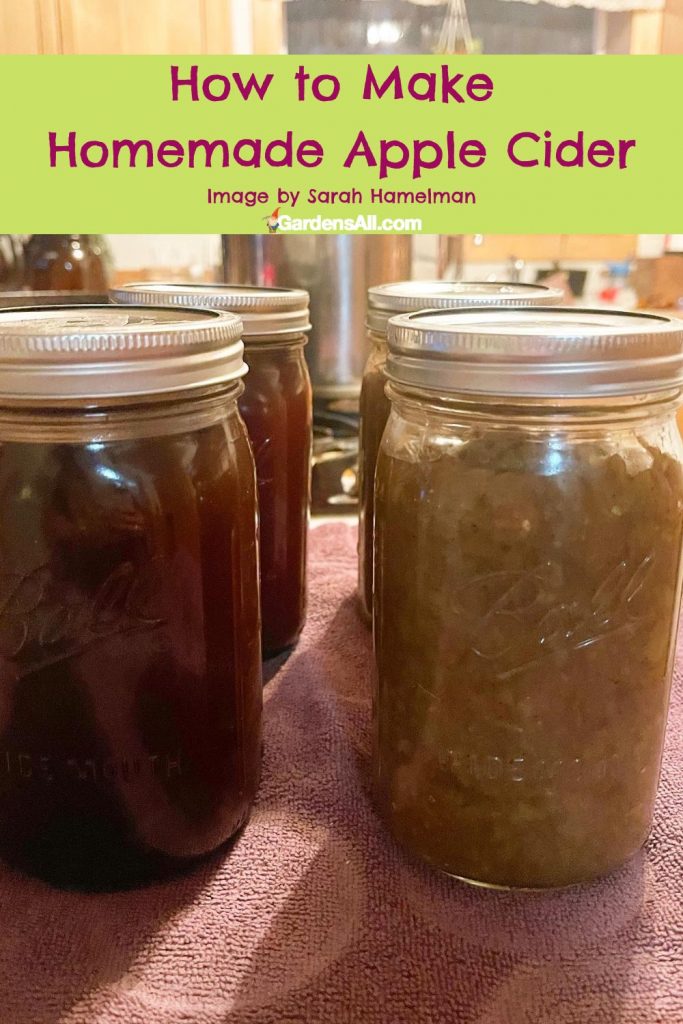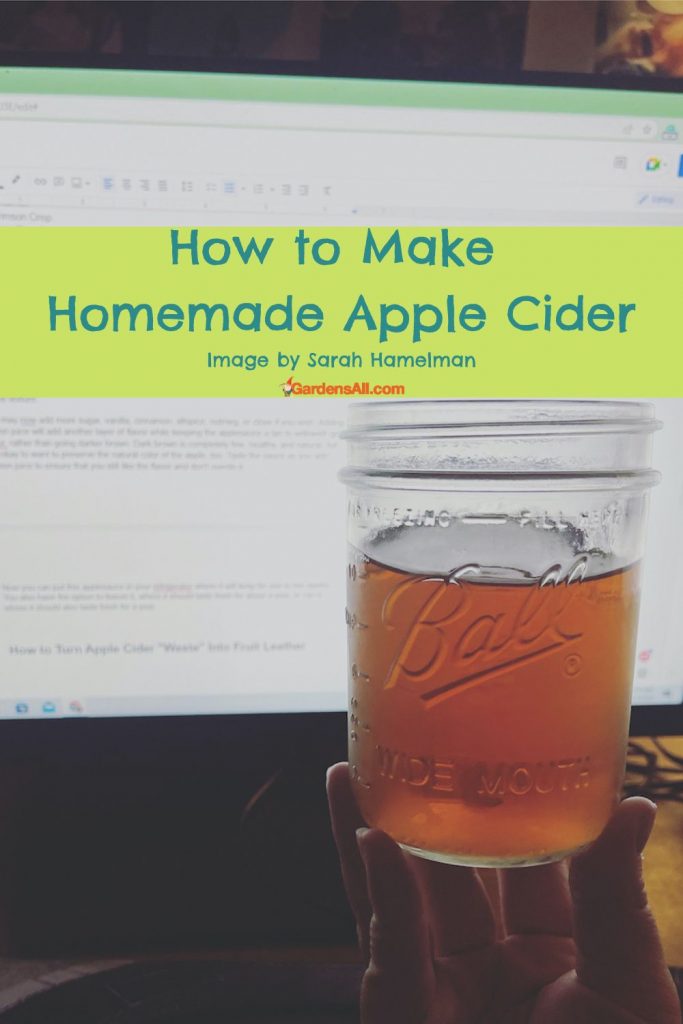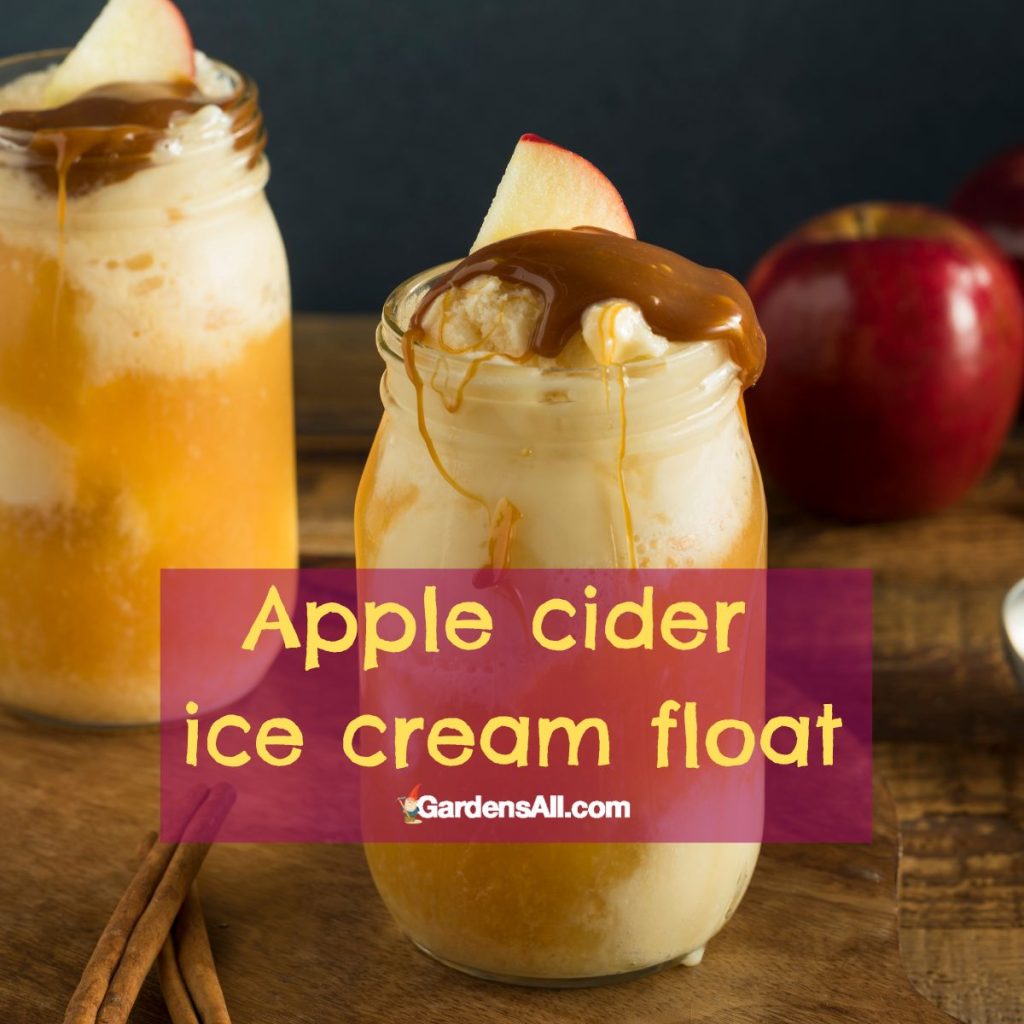If you’re looking for help on how to make homemade apple cider, chances are it’s autumn, or soon will be. Making apple cider in mid-September always signals a shift into fall for me.
So as I’m prepping and making apple cider from our apple trees, we will show you how to make non-alcoholic apple cider as well as cider with alcohol. We’ll also cover which apples to use, how to make cider from fresh apples, or juice, and how to turn the leftovers from your cider into flavorful applesauce or fruit leather.
How Many Apples in a Pound? Approximately…
- 2 large apples = 1 lb.
- 3 medium apples = 1 lb.
- 5 small apples = 1 lb.
This recipe goes by the pound rather than by the number of apples, to make the recipe more accurate.
Not everyone has access to a food scale though, and we want to accommodate all cider enthusiasts, so here’s a general guide.
- There are approximately two large apples in a pound. For this recipe, use eight apples.
- Three medium apples make a pound. For this recipe, use twelve.
- Five small apples will roughly add up to a pound. For this recipe, use sixteen to twenty.
Many gardeners prefer to use their ugliest apples to make cider, applesauce, and fruit leather because the blemishes can easily be cut off without affecting the appearance of the meal. But do not use rotten, moldy, or mildewy apples.
It’s okay to use bruised, cut, or even insect-touched apples. Slice off the damaged bits and use the rest of the apple for the recipe. If you do need to cut off some pieces, remember that you will need to add more apples to make up for what you have taken off. This seems obvious, but it’s an easy detail to forget once you get started.
Which Apples to Use for Apple Cider
The apples you should use for cider completely depends on your taste and what you have available.
It is completely okay to use one variety of apple, especially if you are growing your own orchard. If you have access to more, your cider will have more depth, layers, and flavor.
Apples for Making a Sweeter Apple Cider
If you prefer a sweeter cider, try using one or more of the following apples:
- Golden Delicious
- Red Delicious
- Yellow Delicious
- Gala
- Sweet 16
- Splendour
- Cortland
- Honeycrisp
- Fuji (or my personal favorite, Daybreak Fuji)
Looking for something a bit more tart or acidic flavor?
Apples for Making a Tarter Apple Cider
- Pristine
- Pink Lady
- Goldrush
- Braeburn
- Melrose
- St. Winesap
- Jonathon
- McIntosh
Finally, these apples have a good blend of sweet and tart flavors:
Sweet and Tart Apple Cider
- Zestar
- Ginger Gold
- Blondee
- Swiss Gourmet
- Jonamac
- Crimson Crisp
- Pixie Crunch
- Suncrisp
- Golden Russet
- Camero
- Virginia Gold

How to Turn Apple Cider Refuse Into Applesauce
After you have taken your liquid from the batch of apples you boiled, you’ll be left with solid apple pieces. Remove the cinnamon sticks. I like to put those in a few random cider jars, but what you do with them is completely up to you.
Take the leftover apple pieces and blend them in small batches. You should pulse them to the desired consistency you prefer in applesauce. Most people prefer smooth, but a few of us like a few small lumps left in for a more interesting texture.
You may now add more sugar, vanilla, cinnamon, allspice, nutmeg, or clove if you wish. Adding lemon juice will add another layer of flavor while keeping the applesauce a tan to yellowish gold color, rather than going darker brown. Dark brown is completely fine, healthy, and natural, but it’s okay to want to preserve the natural color of the apple, too. Taste the sauce as you add lemon juice to ensure that you still like the flavor and don’t overdo it.
Now you can put this applesauce in your refrigerator where it will keep for one to two weeks. You also have the option to freeze it, where it should taste fresh for about a year, or can it, where it should also taste fresh for a year.

How to Turn Apple Cider “Waste” Into Fruit Leather
If you want a delicious fruit leather that will remind you of fall, this is the best way to do it.
Remove the cooked fruit from the pot to blend or puree it. You can use a blender or a food processor. Make sure you pick out your cinnamon sticks first, because you do not want those to go into your fruit leather.
If you want to add more sugar, spices, vanilla, or lemon, now is your chance to do that.
Next, line a rimmed baking sheet with a reusable silicon sheet. Pour the puree onto the sheet until it is about an eighth to a quarter of an inch thick.
Place this in the oven, and set the oven to 140 degrees Fahrenheit. The thicker your pour, the longer it will take to dry. Most of the time, this will take eight to twelve hours. I would suggest starting this in the morning so you can monitor your oven all day, but I know that some prefer to do this overnight while they sleep.
Your fruit leather is ready when you can poke it with a utensil and it isn’t sticky at all. When it is dry, remove it from the oven and let it cool for a moment.
Now you can roll up your fruit leather and store it in an airtight container in the pantry, refrigerator, or freezer. It lasts about a month in a cool dark pantry, a couple of months (or longer) in the refrigerator, and at least a year in the freezer.
How to Make Apple Cider from Fresh Apples
Fresh Apple Cider Recipe

Homemade apple cider is easy to make and an awesome thing to do.
While you can find good apples year round these days, it's especially good to do in fall and winter when you can find more local fresh apple harvests.
So let's get to it!
Ingredients
- 4 pounds apples, diced
- 1 orange, sliced
- 5 cinnamon sticks
- 1 Tablespoons ground cloves
- 1 Tablespoons ground allspice
- 1 Tablespoons ground nutmeg
- 1 Tablespoons vanilla (optional)
- 1/2 cup packed brown sugar
- Water
Instructions
- Core and quarter all of the apples. Leave the skin on for added taste and nutrition, or peel the skins if you intend to create applesauce and don't want the skins to end up there.
- In a large or extra-large stock pot, add the apples, orange, spices, vanilla, and brown sugar. Add water to the pot until your apples begin to float one to two inches off the bottom of the stockpot. The more water you add, the more cider you'll have, but at the expense of a more diluted flavor.
- Turn the heat to medium-low or medium. You should bring the mixture to a boil, and then immediately reduce the heat to a simmer. Once it is simmering, cover it and leave it to simmer for two hours. The apples should be very soft and falling apart when touched.
- Using a potato masher, mash the apples and orange pieces. Stir well.
- Remove the cinnamon sticks and orange pieces. They can later be added into your serving bowl for presentation, or the cinnamon sticks can be dropped into your canning jars if you can the cider.
- Strain all of the solids from the cider. Use a fine-mesh strainer or a cheesecloth. Squeeze all of the juices from the solids because this is where a ton of the flavor hides.
- Immediately serve it warm. You can also can or freeze it for another day.
Notes
Making Apple Cider from Fresh Apples - image by Sarah Hamelman
Nutrition Information:
Yield:
1Serving Size:
1Amount Per Serving: Calories: 1481Total Fat: 7gSaturated Fat: 3gTrans Fat: 0gUnsaturated Fat: 2gCholesterol: 0mgSodium: 80mgCarbohydrates: 376gFiber: 55gSugar: 291gProtein: 8g
How to Make Cider with Apple Juice
Making Apple Cider from Apple Juice

If you want a hot apple cider recipe easy and quickly, apple juice is a great shortcut that still tastes great and, depending on where it was sourced, can be just as healthy as fresh apples.
Ingredients
- 4 c apple juice (sweetened or unsweetened, your decision)
- 1/2 orange
- 1 tbsp ground cloves
- 1 tbsp ground allspice
- 1 tbsp ground nutmeg
- 1 tbsp vanilla (optional)
- 1/4 c brown sugar (optional)
Instructions
- Add all of these above ingredients into a sauce pan on medium heat.
- When it starts to boil, reduce it to a simmer, cover it, and allow it to continue simmering for thirty to sixty minutes. The longer it simmers, the stronger it will be.
- You may remove the spices and orange, or leave them in as garnish.
- Immediately serve while warm. This recipe can also be refrigerated, frozen, or canned.

How to Make Apple Cider Vinegar?
Apple cider vinegar can be made using your apple cider, or apple scraps. You can read up on how to make homemade apple cider vinegar here.
How to Make Apple Cider Non-Alcoholic
To make apple cider non-alcoholic, drink it all within the first ten days.
To keep the cider long-term without allowing it to become alcoholic, freeze it or can it.
How to Make Cider Alcoholic
The easiest way to make apple cider alcoholic is to forget about it in the back of your fridge or pantry for a few weeks! 😊 There are more complex ways to make hard cider, however, it is a natural process that can be done more simply.
For a quicker easier hard cider, you might prefer a cider making kit such as these on Amazon:
It takes about two weeks for cider to ferment. This fermentation process occurs when cider is exposed to oxygen and creates a reaction with the cider’s natural sugars to create acid. If you add sugar to your batch of cider, the process will take longer. It can also take longer if you use apple juice that has preservatives added.
When it does start to “turn” it is not dangerous, but will take on a vinegary flavor, froth, and taste more sour. Technically, cider never goes bad, it just gets more alcoholic and then more acidic. This is also how to make apple cider vinegar is created.
You can add one teaspoon of yeast once the cider is about the same temperature as a nice warm bath. Shake well, you’ll see bubbles. This will speed up the fermentation process.
Set your cider aside in a cool and dark place where it can ferment and bubble. After about a month, the bubbling will subside and you’ll know that your hard apple cider is ready to enjoy. Drink it up with friends right away or bottle it for later.
RELATED: find info on homemade ginger ale here.
What to Serve with Apple Cider
French Vanilla Ice Cream
While I love a plain apple cider on its own, I have to admit that its even better with a scoop of French vanilla ice cream dropped into it. It’s like a warm hug from an apple pie in drink form.

Squash Soup
Squash and apples go together with fall like peanut butter goes with jelly. This flawless fall classic combination will make you feel all kinds of warm and cozy.
Camembert and Cheddar Cheeses
Strong cheeses complement apple cider nicely. Try a camembert grilled cheese sandwich, a cheddar flatbread or panini, a camembert casserole, or a camembert sauce or pizza.
Roasted Thanksgiving Turkey
If you’ve got a slice of juicy turkey, a spoonful of dressing, and a dollop of cranberry pear sauce with rosemary and ginger. and a big pumpkin pie with whipped cream waiting for you, you have to have a hot mug filled with apple cider to wash it all down.
Pancakes and Waffles
While you may not think that pancakes or waffles pair well with apple cider, maple syrup sure does. If you’re out to brunch, try swapping sparkling wine for cider in your mimosa.
Quiche
Not in the mood for pancakes and waffles, but still want cider for breakfast or brunch? Try quiche, egg bake or frittata. It is especially delicious when you mix bacon, ham, Swiss, or cheddar cheese into the quiche. Lorraine and leek quiche is another scrumptious option.

I’m LeAura Alderson, a garden, herb and plant enthusiast with a passion for discovering the many edible and medicinal benefits of the plants all around us, including the weeds! I’m a writer, editor and media publisher for our family of websites.
While I was certified in fitness and life coaching, I am NOT a health practitioner. However, I’m a lifelong health enthusiast, with a keen interest in healthy, organic foods and making home remedies and the content we share is from our own experience and usage as well as that extracted from scientific research so that you can explore further on your own.
Always seek the advice and guidance of your health practitioners first and foremost.
As a family we’re steadily expanding our gardening, experimentation and knowledge around all things gardening, edible landscaping, fresh organic foods and self sustainability with farming in our future. I also own and manage iCreateDaily.com, a site all about transformation through creation, and the power of positivity, optimism and mindset.

